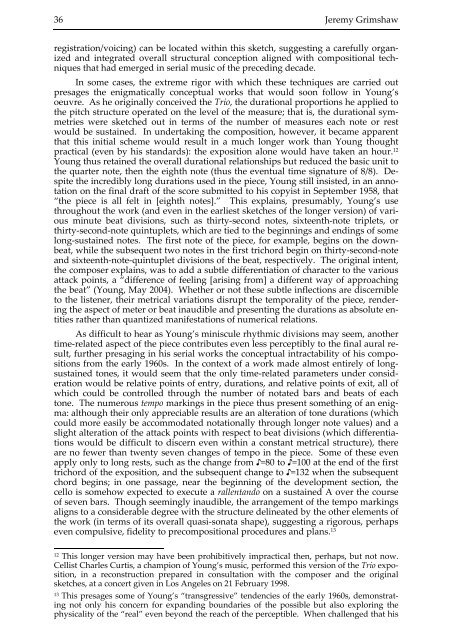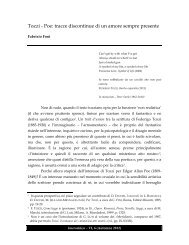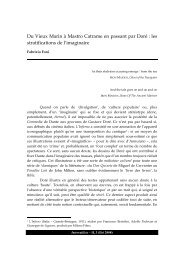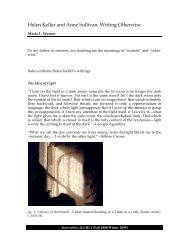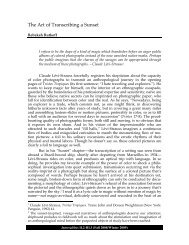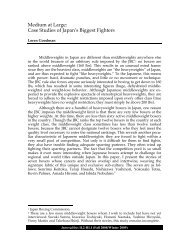The Tabula (not so) Rasa: La Monte Young's Serial Works ... - Cipa
The Tabula (not so) Rasa: La Monte Young's Serial Works ... - Cipa
The Tabula (not so) Rasa: La Monte Young's Serial Works ... - Cipa
Create successful ePaper yourself
Turn your PDF publications into a flip-book with our unique Google optimized e-Paper software.
36 Jeremy Grimshaw<br />
registration/voicing) can be located within this sketch, suggesting a carefully organized<br />
and integrated overall structural conception aligned with compositional techniques<br />
that had emerged in serial music of the preceding decade.<br />
In <strong>so</strong>me cases, the extreme rigor with which these techniques are carried out<br />
presages the enigmatically conceptual works that would <strong>so</strong>on follow in Young’s<br />
oeuvre. As he originally conceived the Trio, the durational proportions he applied to<br />
the pitch structure operated on the level of the measure; that is, the durational symmetries<br />
were sketched out in terms of the number of measures each <strong>not</strong>e or rest<br />
would be sustained. In undertaking the composition, however, it became apparent<br />
that this initial scheme would result in a much longer work than Young thought<br />
practical (even by his standards): the exposition alone would have taken an hour. 12<br />
Young thus retained the overall durational relationships but reduced the basic unit to<br />
the quarter <strong>not</strong>e, then the eighth <strong>not</strong>e (thus the eventual time signature of 8/8). Despite<br />
the incredibly long durations used in the piece, Young still insisted, in an an<strong>not</strong>ation<br />
on the final draft of the score submitted to his copyist in September 1958, that<br />
“the piece is all felt in [eighth <strong>not</strong>es].” This explains, presumably, Young’s use<br />
throughout the work (and even in the earliest sketches of the longer version) of various<br />
minute beat divisions, such as thirty-second <strong>not</strong>es, sixteenth-<strong>not</strong>e triplets, or<br />
thirty-second-<strong>not</strong>e quintuplets, which are tied to the beginnings and endings of <strong>so</strong>me<br />
long-sustained <strong>not</strong>es. <strong>The</strong> first <strong>not</strong>e of the piece, for example, begins on the downbeat,<br />
while the subsequent two <strong>not</strong>es in the first trichord begin on thirty-second-<strong>not</strong>e<br />
and sixteenth-<strong>not</strong>e-quintuplet divisions of the beat, respectively. <strong>The</strong> original intent,<br />
the composer explains, was to add a subtle differentiation of character to the various<br />
attack points, a “difference of feeling [arising from] a different way of approaching<br />
the beat” (Young, May 2004). Whether or <strong>not</strong> these subtle inflections are discernible<br />
to the listener, their metrical variations disrupt the temporality of the piece, rendering<br />
the aspect of meter or beat inaudible and presenting the durations as ab<strong>so</strong>lute entities<br />
rather than quantized manifestations of numerical relations.<br />
As difficult to hear as Young’s miniscule rhythmic divisions may seem, a<strong>not</strong>her<br />
time-related aspect of the piece contributes even less perceptibly to the final aural result,<br />
further presaging in his serial works the conceptual intractability of his compositions<br />
from the early 1960s. In the context of a work made almost entirely of longsustained<br />
tones, it would seem that the only time-related parameters under consideration<br />
would be relative points of entry, durations, and relative points of exit, all of<br />
which could be controlled through the number of <strong>not</strong>ated bars and beats of each<br />
tone. <strong>The</strong> numerous tempo markings in the piece thus present <strong>so</strong>mething of an enigma:<br />
although their only appreciable results are an alteration of tone durations (which<br />
could more easily be accommodated <strong>not</strong>ationally through longer <strong>not</strong>e values) and a<br />
slight alteration of the attack points with respect to beat divisions (which differentiations<br />
would be difficult to discern even within a constant metrical structure), there<br />
are no fewer than twenty seven changes of tempo in the piece. Some of these even<br />
apply only to long rests, such as the change from ♪=80 to ♪=100 at the end of the first<br />
trichord of the exposition, and the subsequent change to ♪=132 when the subsequent<br />
chord begins; in one passage, near the beginning of the development section, the<br />
cello is <strong>so</strong>mehow expected to execute a rallentando on a sustained A over the course<br />
of seven bars. Though seemingly inaudible, the arrangement of the tempo markings<br />
aligns to a considerable degree with the structure delineated by the other elements of<br />
the work (in terms of its overall quasi-<strong>so</strong>nata shape), suggesting a rigorous, perhaps<br />
even compulsive, fidelity to precompositional procedures and plans. 13<br />
12 This longer version may have been prohibitively impractical then, perhaps, but <strong>not</strong> now.<br />
Cellist Charles Curtis, a champion of Young’s music, performed this version of the Trio exposition,<br />
in a reconstruction prepared in consultation with the composer and the original<br />
sketches, at a concert given in Los Angeles on 21 February 1998.<br />
13 This presages <strong>so</strong>me of Young’s “transgressive” tendencies of the early 1960s, demonstrating<br />
<strong>not</strong> only his concern for expanding boundaries of the possible but al<strong>so</strong> exploring the<br />
physicality of the “real” even beyond the reach of the perceptible. When challenged that his


